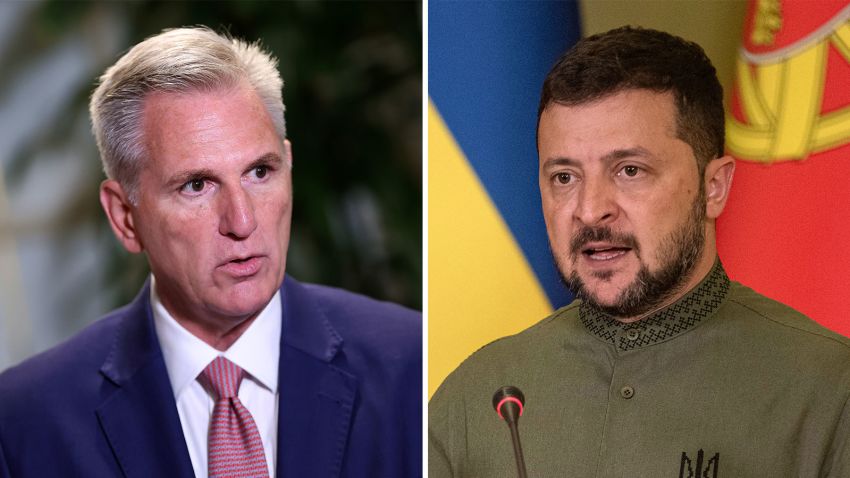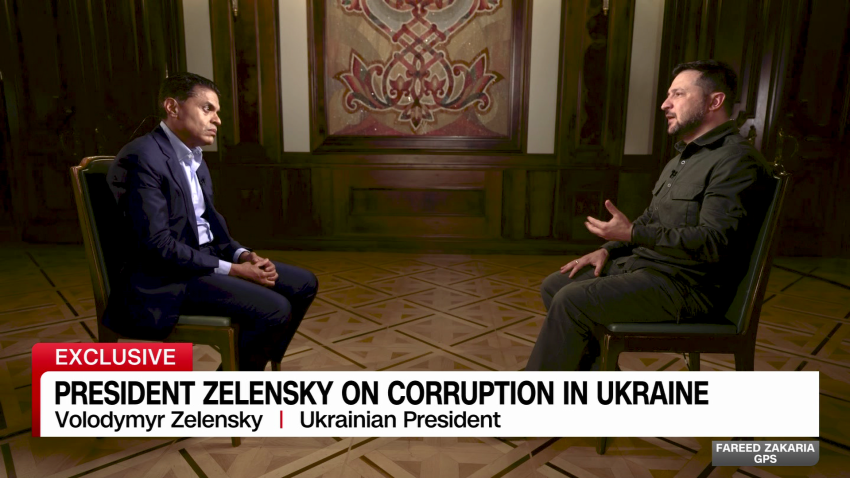
A version of this story appears in CNN’s What Matters newsletter. To get it in your inbox, sign up for free here.
CNN
—
Days after President Joe Biden declared unyielding support for Ukraine in its fight against Russia, the domestic US political fight is threatening aid funding – and Ukrainian President Volodymyr Zelensky encountered less-than-open arms from Republican leaders on Capitol Hill.
Poland also announced this week it would no longer arm its neighbor Ukraine. Read more from CNN’s Rob Picheta about that surprise development, which is born of a looming election in Poland and a standoff with the European Union over Ukraine’s grain supply.
Back in the US, for the clearest example of how the ground has shifted, watch the video below: a side-by-side comparison of comments from House Speaker Kevin McCarthy, who was the Republican minority leader in March 2022 when Zelensky addressed a joint session of Congress virtually. The Ukrainian leader spoke again to all US lawmakers in person in December. The House was united, McCarthy said last March, “to help Ukraine get the weaponry they need to defend themselves.”

Watch McCarthy react to Zelensky’s visit in 2022 vs. now
Now, after Congress committed so many billions in aid to Ukraine during votes in one calendar year and a US election catapulted him to House speaker, McCarthy has questions about accountability and further funding.
And rather than again give Zelensky the platform of a joint session before Congress, McCarthy gave Zelensky a meeting behind closed doors. Those optics, or lack thereof, are important.
Money is the main topic of conversation on Capitol Hill at the moment
The US government is about to run out of funding and a government shutdown is on the horizon.
In August, as part of a larger request that included domestic disaster relief funding, the White House asked Congress to approve another $24 billion for Ukraine. This money would go to a variety of things, including replenishing the Pentagon’s arsenal with equipment sent to Ukraine.
The most recent short-term funding bill pushed by Republicans included neither the disaster funding nor the Ukraine funding. But negotiations continue.
The existing Ukraine aid was all approved before Republicans took control of the House in a series of spending bills over the course of 2022. It has been spent in multiple disbursements by the Biden administration across the intervening months.
The total dollar figure the US has provided to Ukraine dwarfs any other individual country.
However, the US is a much wealthier country than those that surround Ukraine, which suggests other countries may have given a larger comparative amount.
So far, Congress has approved about $113 billion in aid to Ukraine, according to calculations by the US State Department Office of Inspector General and the Committee for a Responsible Federal Budget.
That includes more than $62 billion intended to go through the Pentagon and more than $46 billion intended to go through the Department of State and the US Agency for International Development.
To place the $113 billion appropriated by Congress for Ukraine in 2022 in context, that’s a little more than it spends in one year on the Department of the Interior and a little less than it spends on the Department of Commerce, according to official government tallies.
The larger Pentagon budget is authorized to be $886 billion next year. The US also spends trillions each year on its safety net with programs like Social Security and Medicare.
The US has actually spent a bit more than $43 billion on security aid for Ukraine since Russia’s invasion in February 2022.
The figure pops up to more than $44 billion during the Biden administration and more than $46 billion since 2014, when Russia first seized portions of Ukraine, according to the State Department.
A lot of firepower. Start with 300 million rounds of ammunition and millions of artillery rounds.
The Pentagon and State Department have a list of what the billions in US aid have gone to since Biden took office.
It includes 198 Howitzers for those millions of artillery rounds; 31 Abrams tanks; hundreds of Bradley infantry fighting vehicles; hundreds of armored personnel vehicles; anti-tank systems like the Javelin; NASAMS (national advanced surface-to-air missile systems) and HAWK air defense systems; river patrol boats; medical supplies; night vision devices; cold weather gear; and spare parts.
Pretty much everything you could imagine short of F-16 fighter jets, which are to be provided by other countries.
It’s used for a very wide variety of things, according to the review by CRFB – everything from helping provide food security to helping rebuild Ukraine’s infrastructure.
There have been indications of corruption. Zelensky, for instance, replaced the leadership at his defense ministry just before traveling to the US to address the United Nations and appear at the White House with Biden.

On GPS: Zelensky on Ukraine’s corruption challenge, coping with war
CNN’s Fareed Zakaria asked Zelensky how he would stop corruption. Zelensky argued money from partners like the US was not involved in the case of the defense minister – but that answer will not quiet calls in the US for more transparency and accountability.
Russia failed to overrun Ukraine, and in fact, Ukraine has launched a counteroffensive to retake territory from Russia. It has been slow going, but Ukraine has claimed new inroads this week in its effort to beat Russia back.
Experts say that without continued financial support, Ukraine would have trouble continuing to stand up to Russia.
CNN’s Ariel Edwards-Levy notes that multiple recent surveys suggest Republicans would like to see the US scale back its support of Ukraine.
Much of the public overall continues to favor actions such as sanctions against Russia and help with Ukrainian intelligence gathering.
A CNN poll released earlier this summer charted growing Republican opposition to aid in Ukraine, and found 55% of the full public opposed to Congress authorizing more funding to support Ukraine, rising to 71% among Republicans. A majority of the public overall did favor some specific forms of aid, such as help with intelligence gathering (63% support) and military training (53% support).
Polling from other organizations this fall has confirmed this shift.
The CNN/University of New Hampshire poll released Wednesday helps further demonstrate the divides on Ukraine within the GOP, according to Edwards-Levy.
It finds 59% of likely Republican primary voters in New Hampshire support stopping all military funding for Ukraine, with 29% opposed and the rest neutral or unsure. An 84% majority of those backing former President Donald Trump in the primary favor cutting off aid to Ukraine, far higher than the level of support for this proposal among the rest of the GOP electorate (39%).
